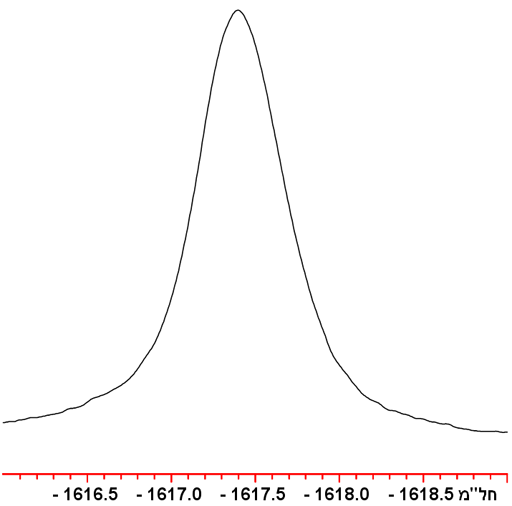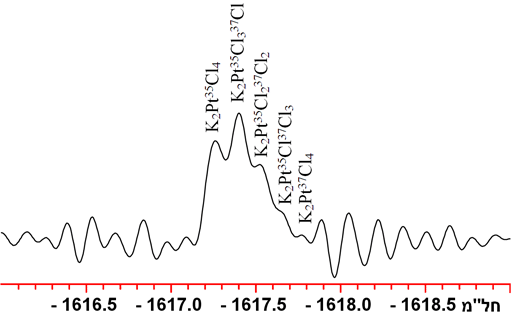תמג פלטינה (195Pt)
לפלטינה (Pt) יש גרעין פעיל תמ"ג אחד עם ספין חצי, 195Pt שנותן סיגנלים חדים פרוס על תחום היסט כימי רחב מאוד (תרשים 1). מאחר שיש לפלטינה תחום היסט כימי כה רחב ומשום של-195Pt סיגנלים חדים, כל תופעה זעירה ביותר מופרד כמו בתרשים 2 כאשר ההחלפה בים 35Cl ו-37Cl נותן סיגנלים נוספים. משתמשים בתמ"ג 195פלטינה לחקר תרכובות פלטינה, מבניהם, הדינמיקה שלהם וקישור פלטינה עם מערכות ביולוגיות. מאחר שמשתמשים רבות בפלטינה כקטליזטור תעשייתית וברפואה, הכימיה שלו נחקר רבות.
תרשים 1. ספקטרום תמ"ג 195Pt של K2PtCl4 ב-D2O

תרשים 2. ספקטרום תמ"ג 195Pt עם הגברת הפרדה של K2PtCl4 ב-D2O שמראה איזוטופומרים

לכל סוג של פלטינה יש תחום היסט כימי אופייני (תרשים 3).
תרשים 3. טווחי היסט כימי של תמ"ג פלטינה

פלטינה מראה צימוד לגרעינים אחרים רבים, 1H, 13C, 15N, 31P, וכו'. קבועי צימוד דו-קשריים לפרוטון בין 25 ו-90 הרץ. קבועי צימוד חד-קשריים 195Pt-15N הם בין 160 ו-390 הרץ. צימוד ל-31P בסביבות 1300 ל-4000 הרץ עבור חד-קשרי ו-30 הרץ עבור דו קשרי. צימוד חד-קשרי ל-77Se בין 80 ל-250 הרץ. הצימוד מפלטינה ל-119Sn הוא גדול במיוחד ויכול להיות יותר מ-33000 הרץ. דווח גם על צימוד פלטינה הומוגרעיני.
תכונות גרעין ה-195Pt
| תכונה | ערך |
|---|---|
| ספין | 1/2 |
| שכיחות בטבע | 33.832% |
| תחום ההיסט הכימי | 6700 ppm, בין -200 ל-6500 |
| יחס התדירויות (Ξ) | 21.496784% |
| חומר יחוס (נקודת אפס יחסית) | 1.2 M Na2PtCl6 ב-D2O |
| רוחב פס של חומר הייחוס | 5.3 הרץ |
| זמן התפוגה T1 של חומר הייחוס | 0.4 שניות |
| רגישות יחסית ל-1H בשכיחות טבעית | 3.51 × 10-3 |
| רגישות יחסית ל-1H כאשר מועשר | 0.0104 |
| רגישות יחסית ל-13C בשכיחות טבעית | 20.7 |
| רגישות יחסית ל-13C כאשר מועשר | 61.2 |
מקורות
- E. M. Badley, B. J. L. Kilby, and R. L. Richards, "NMR spectra of carbene complexes of platinum (II)", J. Organometal. Chem., 27, C37-C38 (1971).
- S. M. Cohen and T. H. Brown, "Temperature dependence of platinum-195 nuclear resonance chemical shifts", J. Chem. Phys., 61, 2985-2986 (1974).
- L. P. Goggin, R. J. Goodfellow, S. R. Haddock, B. F. Taylor and I. R. H. Marshall, "The platinum-195 chemical shift in some platinum (0) and platinum (II) complexes and its relationship to their structure", J. Chem. Soc., Dalton Trans., 459-467 (1976).
- C. Brown, B. T. Heaton, P. Chini, A. Fumagalli and G. Longoni, "Stereochemical nonrigidity of a metal polyhedron; Fourier transform platinum-195 nuclear magnetic resonance spectra of [Ptn(CO)2n]2- (n = 3,6, or 9)", J. Chem. Soc., Chem. Comm., 309-311 (1977).
- S. S. Kurasova, S. N. Ivanova, L. Y. Al't, L. M. Gindin, A. A. Bezzubenko and V. A. Ershova, "Platinum-195 NMR study of the state of platinum in extracts with octylaniline", Seriya Khim. Nauk, 66-70 (1978).
- S. J. S. Kerrison and P. J. Sadler, "The convention for referencing platinum-195 NMR shifts and the cooperative shift effect for chloro-bromo complexes of platinum (IV) and -(II)", J. Magn. Reson., 31, 321-325 (1978).
- P. J. Sadler, "195-platinum NMR on the FX60" JEOL News, 15A, 16 (1979).
- J. Soulie, J. Y. Lallemand and R. C. Rao, "Platinum-195 NMR studies on monomer and dimer complexes. Observation of platinum - platinum coupling constants", Org. Magn. Reson., 12, 67-70 (1979).
- I. M. Al-Najjar, M. Green, S. Kerrison and P. J. Sadler, "Trans effects in platinum (II) complexes: platinum-195 nuclear magnetic resonance of nitrogen-15-labeled amine complexes", J. Chem. Res., Syn., 206-207 (1979).
- J. H. Nelson, V. Cooper and R. W. Rudolph, "The nature of platinum trichlorostannate salts in solution by multinuclear NMR. Unusually large spin-spin coupling, cluster size, fluxionality, and a caveat", Inorg. Nucl. Chem. Lett., 16, 263-265 (1980).
- G. K. Anderson, R. J. Cross and D. S. Rycroft, "Multinuclear magnetic resonance: sign of 1J(195Pt-13C), and platinum-195 chemical shifts in carbonyl complexes of platinum (II)", J. Chem. Res., Syn., 240-241 (1980).
- I. M. Ismail, S. J. S. Kerrison and P. J. Sadler, "Chlorine and bromine isotope shifts in platinum-195 NMR spectra", J. Chem. Soc., Chem. Comm., 1175-1176 (1980).
- S. J. S. Kerrison and P. J. Sadler, "Coordination of amides to cis-diamminediaquaplatinum dication", J. Chem. Soc., Chem. Comm., 61-62 (1981).
- Y. Koie, S. Shinoda and Y. Saito, "Platinum-195 nuclear magnetic resonance study of platinum (0) complexes containing a series of acetylenes", J. Chem. Soc., Dalton Trans., 1082 (1981).
- M. Hirayama and Y. Sasaki, "Observation of lanthanoid-induced platinum-195 shifts for the adduct of bis(acetylacetonato) platinum (II) with tris(8,8,8,7,7,6,6-heptafluoro-2,2-dimethyloctane-3,5-dionato)praseodymium(III) in trichloromethane-d solution", Chem. Lett., 195-196 (1982).
- S. K. Boocock, N. N. Greenwood, J. D. Kennedy, W. S. McDonald and J. Staves, "The chemistry of isomers of icosaborane(26), B20H26: synthesis and nuclear magnetic resonance study of various isomers of platinahenicosaboranes and diplatinadocosaboranes, and the x-ray crystal and molecular structures of 7,7-bis(dimethylphenylphosphine)-nido-7-platinaundecaborane and 4-(2'-nido-decaboranyl)-7,7-bis(dimethylphenylphosphine)-nido-7-platinaundecaborane", J. Chem. Soc., Dalton Trans., 2573-2584 (1981).
- K. H. A. Ostoja Starzewski, P. S. Pregosin and H. Ruegger, "Phosphorus-31, tin-119 and platinum-195 NMR studies of trichlorostannate complexes of Pt(II) and Pd(II). 2J 119Sn,117Sn)-values", Helv. Chim. Acta, 65, 785-797 (1982).
- L. Y. Alt, V. P. Mel'nikova, A. N. Startsev and V. K. Duplyakin, "Platinum-195 and tin-119 NMR studies of platinum-tin complexes in the platinum (II)-tin(II)-isopropyl alcohol system", React. Kinet. Catal. Lett., 23, 21-23 (1983).
- P. S. Pregosin and H. Ruegger, "Tin-119 and platinum-195 NMR spectroscopy of trichlorostannate(II) complexes of platinum and palladium. Some chemistry of the complexes (Ph4P)2[PtCl4] and [Pt(m-Cl)Cl(PEt3)]2 with tin(II) chloride", Inorg. Chim. Acta, 86, 55-60 (1984).
- T. G. Appleton, J. R. Hall and S. F. Ralph, "Nitrogen-15 and platinum-195 NMR spectra of platinum ammine complexes: trans- and cis-influence series based on platinum-195-nitrogen-15 coupling constants and nitrogen-15 chemical shifts", Inorg. Chem., 24, 4685-4693 (1985).
- D. D. Gummin, E. M. A. Ratilla and N. M. Kostic, "Variable-temperature platinum-195 NMR spectroscopy, a new technique for the study of stereodynamics. Sulfur inversion in a platinum (II) complex with methionine", Inorg. Chem., 25, 2429-2433 (1986).
- E. G. Hope, W. Levason and N. A. Powell, "Coordination chemistry of higher oxidation states. Part 21. Platinum-195 NMR studies of platinum (II) and platinum (IV) complexes of bi- and multi-dentate phosphorus, arsenic and sulfur ligands", Inorg. Chim. Acta, 115, 187-192 (1986).
- D. E. Berry, K. A. Beveridge, J. Browning, G. W. Bushnell and K. R. Dixon, "Ligand properties of phosphinito platinum complexes: phosphorus-31 and platinum-195 nuclear magnetic resonance studies and the crystal and molecular structure of [Cl(Et3P)Pt(m-PPh2O)2Pt(PEt3)2][BF4]", Can. J. Chem., 644, 1903-1911 (1986).
- H. J. Ruegg, P. S. Pregosin, A. Scrivanti, L. Toniolo and C. Botteghi, "Platinum (II) trichlorostannate chemistry. Importance of the platinum-tin linkage in hydroformylation chemistry and a novel PtC(OSnC12)R carbine", J. Organometal. Chem., 316, 233-241 (1986).
- P. Salvadori, G. Uccello-Barretta, S. Bertozzi, R. Settambolo and R. Lazzaroni, "Determination of the enantiomeric purity of chiral allyl alcohols and allyl ethers by platinum-195 NMR spectroscopy", J. Org. Chem., 53, 5768-5770 (1988).
- E. W. Abel, N. J. Long, K. G. Orrell, A. G. Osborne and V. Sik, "The syntheses, structures and stereodynamics of [3]ferrocenophane complexes. II. Trimethylplatinum(IV) halide complexes, [PtXMe3[(C5H4ECH3)2Fe]] (E = sulfur, selenium; X = chlorine, bromine, iodine)", J. Organometal. Chem., 378, 473-483 (1989).
- E. Baralt and C. M. Lukehart, "Phosphorus-31 and platinum-195 NMR data of several "T-frame" diplatinum complexes that exhibit unusual structure, bonding, and reactivity", Inorg. Chem., 29, 2870-2872 (1990).
- P. Salvadori, G. Uccello-Barretta, R. Lazzaroni and A. M. Caporusso, "A new method for the enantiomeric excess determination of chiral trisubstituted allenes by platinum-195 NMR of trans-dichloro[(S)-α-methylbenzylamine](allene) platinum (II) complexes", J. Chem. Soc., Chem. Comm., 1121-1123 (1990).
- T. Yamaguchi, K. Abe and T. Ito, "195Pt NMR of Tetranuclear Platinum (II) Cluster Complexes That Have Chemically Nonequivalent Nuclei: [Pt4(CH3COO)7(CH3CONH)] and [Pt4(CH3COO)3(CH3CONH)3]", Inorg. Chem., 33, 2689-2691 (1994).
- A. Yamasaki, M. Oike, T. Sugano, Y. Tanakura and T. Kinoshita, "Construction of hetero-atom NMR databases. II. platinum-195 NMR data. 1", Denki Tsushin Daigaku Kiyo, 7, 175-183 (1994).
- J. K. K. Sarhan, "195Pt-NMR studies on azaplatinacyclobutane complexes derived from allenes", Al-Azhar Bull. Sci., 6, 1417-1425 (1995).
- L. F. Krylova and A. V. Golovin, "NMR studies of transformations of Pt(II) and Pd(II) complexes with amino acids in solution. 1. Glycine complexes", J. Struct. Chem., 41, 243-253 (2000).
- A. Knodler, W. Kaim, V. K. Jain and S. Zalis, "Dimethylplatinum(II) and tetramethylplatinum(IV) complexes of 1-methyl-(2-alkylthiomethyl)-1H-benzimidazoles: experimental and DFT-calculated structures and NMR spectra", J. Organometal. Chem., 655, 218-226 (2002).
- M. Bouma, B. Nuijen, D. R. Stewart, K. F. Shannon, J. V. St. John, J. R. Rice, R. Harms, B. A. J. Jansen, S. van Zutphen, J. Reedijk, A. Bult and J. H. Beijnen, "Pharmaceutical quality control of the investigational polymer-conjugated platinum anticancer agent AP 5280", PDA J. Pharmaceut. Sci. Tech., 57, 198-207 (2003).
- F. D. Rochon and V. Buculei, "Study of Pt(II)-cyclic amines complexes of the types cis- and trans-Pt(amine)2I2 and cis- and trans-Pt(amine)2(NO3)2 and their aqueous products by", Inorg. Chim. Acta, 358, 2040-2056 (2005).
- A. Klein, T. Schurr, A. Knoedler, D. Gudat, K.-W. Klinkhammer, V. K. Jain, S. Zalis and W. Kaim, "Multiple Isomerism (cis/trans; syn/anti) in [(dmso)2Pt(aryl)2] Complexes: A Combined Structural, Spectroscopic, and Theoretical Investigation", Organometal., 24, 4125-4131 (2005).
- S. Lanza, G. Callipari, F. Loiseau, S. Serroni and G. Tresoldi, "195Pt NMR of Heteropolymetallic Complexes Containing Secondary Dithiooxamides as Binucleating Ligands", Inorg. Chem., 44, 6717-6724 (2005).
- J. R. L. Priqueler, I. S. Butler and F. D. Rochon, "An overview of 195Pt nuclear magnetic resonance spectroscopy", Appl. Spectrosc. Rev., 41, 185-226 (2006).
בטיחות
הוראת בטיחות: חלק מהחומרים המוזכרים כאן מסוכנים מאוד, יש להתייעץ עם נאמן בטיחות או כימאי לפני העבודה אתם . כאשר החומרים אינם מוכרים על נאמן הבטיחות או הכימאי לחפש בספרות המקצועית מידע בקשר אליהם. הממסים המשמשים לבדיקות תמ"ג הם ברובם דליקים ורעילים. TMS לדוגמא רעיל ודליק, יש להשתמש בכפפות ולעבוד במנדף. במיוחד, מלחי פלטינה אלרגנים: כבוש כפפות מגן.